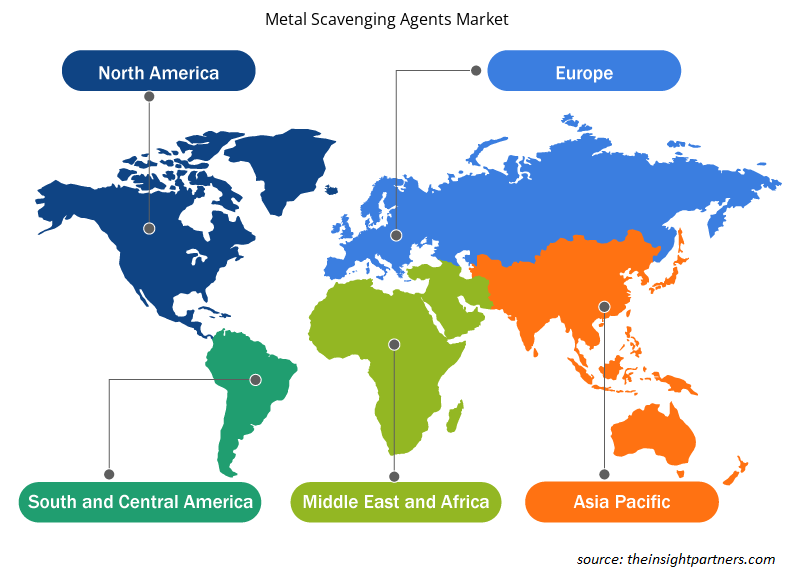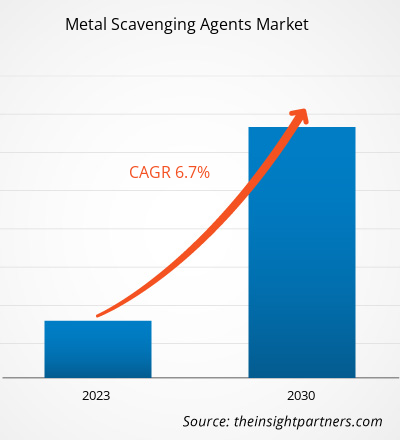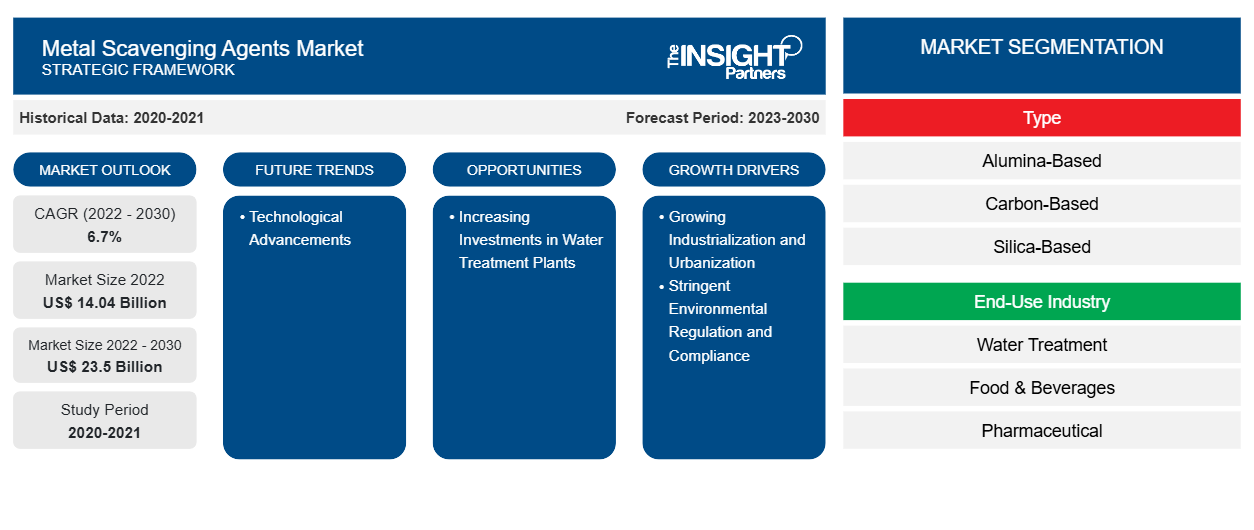[研究报告] 2022年金属清除剂市场价值为 140.4095 亿美元,预计到 2030 年将达到 235.0269 亿美元;预计 2022 年至 2030 年的复合年增长率为 6.7%。
市场分析
金属清除剂是专门设计用于选择性结合和去除溶液或基质中的金属离子的物质。它们用于各种工业过程,例如废水处理、金属回收和化学净化。这些药剂通常含有对特定金属离子具有高亲和力的功能团,使它们能够形成复合物并通过沉淀、吸附或其他分离方法促进其去除。金属清除剂的例子有螯合剂,例如EDTA (乙二胺四乙酸)、DTPA(二乙烯三胺五乙酸)和NTA(腈三乙酸);离子交换树脂;活性炭;和各种聚合物。由于对水处理厂的投资不断增加,全球金属清除剂市场规模到 2030 年可能会激增。
金属清除剂在制药行业中的使用日益增多,对金属清除剂市场的增长做出了重大贡献。在行业中,这些药剂在确保药品的功效、安全性和稳定性方面发挥着至关重要的作用。铜、锌、铁和其他金属离子可加速药物制剂中的氧化、水解和其他化学反应,导致药效降低、外观变化和有毒副产物的形成。金属清除剂在行业中的主要应用是注射剂和静脉注射液等肠外药物的配制。这些制剂易受金属催化氧化的影响,这会导致活性药物成分(API) 降解并导致潜在有害杂质的形成。金属清除剂被添加到肠外制剂中,以螯合水、赋形剂和包装材料中的金属离子,从而防止氧化降解并确保药品在整个保质期内的稳定性。
增长动力与挑战
工业化和城市化进程的加快以及严格的环境法规和合规性推动了金属清除剂市场规模的不断增长。截至 2023 年 7 月,制造业的年度建筑支出总额为 2010 亿美元,比上一年增长 70%,为 2024 年的进一步增长奠定了基础。随着工业活动在世界范围内的扩展,水体、土壤和空气等各种环境介质中的金属污染也在增加。污染来自多种来源,包括工业过程、城市径流和不当的废物处理做法。采矿、制造和化学加工等行业产生的废水和排放物中含有铅、汞、镉和铬等重金属。这些金属会造成严重的环境污染并造成健康风险,因为它们可以在环境中持续存在,在生态系统中积累,并在生物体内生物累积,最终进入食物链并对人类健康和野生动植物构成风险。为了解决重金属污染对环境和健康造成的不利影响,世界各国政府和监管机构都出台了严格的环境法规。各国政府对工业废水和排放物中重金属的允许浓度设定了严格的限制,旨在保护水质、土壤完整性和空气纯度。为了遵守这些法规,各行业被迫部署有效的解决方案,例如金属清除剂,以确保其排放水平达到规定的限值。监管合规压力巨大,因为不合规会导致严重的罚款、处罚和法律后果。然而,实施金属清除解决方案所需的大量初始投资对中小企业 ( SME ) 来说是一个重大障碍,尤其是在资本资源有限的新兴经济体中。在这些地区运营的中小企业往往面临资金限制和相互竞争的优先事项,这使得分配资金用于与金属清除技术相关的昂贵设备、基础设施和专用材料变得具有挑战性。因此,中小企业可能优先考虑当前运营需求,而不是长期环境投资,认为污染控制措施不必要或优先级较低。
定制此报告以满足您的需求
您可以免费定制任何报告,包括本报告的部分内容、国家级分析、Excel 数据包,以及为初创企业和大学提供优惠和折扣
-
获取此报告的关键市场趋势。这个免费样品将包括数据分析,从市场趋势到估计和预测。
报告分类和范围
“全球金属清除剂市场分析与预测(2030 年)”是一项专业而深入的研究,主要关注全球市场趋势和增长机会。该报告旨在概述全球市场,并根据类型、最终用途行业和地区对市场进行详细细分。该报告提供了该地区金属清除剂使用情况的关键统计数据,以及主要国家对金属清除剂的需求。此外,它还对影响主要国家金属清除剂市场增长的各种因素进行了定性评估。它还包括对市场领先参与者及其关键战略发展的全面分析。还包括对市场动态的分析,以帮助确定关键驱动因素、市场趋势和有利可图的机会,进而有助于确定主要收入来源。此外,金属清除剂市场趋势包括技术进步。金属清除技术领域的持续研究和开发工作正在推动先进解决方案的出现,这些解决方案有望彻底改变金属去除工艺。基于纳米材料的吸附剂、功能化膜和混合吸附剂系统等创新可以为在金属清除应用中实现更高的效率、选择性和可持续性提供有希望的途径。
生态系统分析和波特五力分析提供了全球金属清除剂市场的360度视角,有助于了解整个供应链和影响市场增长的各种因素。
节段分析
全球金属清除剂市场根据类型和最终用途行业进行细分。根据类型,市场细分为氧化铝基、碳基、二氧化硅基、树脂基和其他。氧化铝基部分占据了金属清除剂市场的很大份额。氧化铝基金属清除剂是各种工业过程中的关键成分,特别是在制药、水处理和环境修复等行业。氧化铝通常以氧化铝 (Al2O3) 的形式存在,由于其两性性质,具有高表面积和对金属离子的强亲和力。这些药剂擅长通过表面络合、离子交换和化学吸附机制螯合或结合金属离子。在水处理中,氧化铝基金属清除剂用于从受污染的水源中去除砷、铅和铬等重金属,从而保障公众健康。此外,在制药行业,氧化铝基金属清除剂在净化药物制剂方面发挥着重要作用,它能消除可能影响产品质量或对消费者健康构成风险的微量金属杂质。此外,在环境修复工作中,氧化铝基金属清除剂可用于减轻土壤和地下水中的金属污染,帮助恢复受工业活动或意外泄漏影响的生态系统。
根据最终用途行业,全球金属清除剂市场细分为水处理、食品和饮料、制药、石油和天然气、化学品、造纸和纸浆等。石油和天然气部门占据了金属清除剂市场的很大份额。在炼油过程中,金属清除剂用于中和可能催化不良反应(如加氢处理催化剂中毒、焦炭形成和硫化合物降解)的金属污染物。例如,铁和镍会使加氢处理和加氢裂化装置中使用的催化剂失活,从而降低工艺效率并增加运营成本。通过螯合金属离子,清除剂可防止催化剂失活;延长催化剂寿命;并提高汽油、柴油和喷气燃料等精炼产品的产量和质量。
区域分析
该报告详细概述了全球金属清除剂市场的主要区域,包括北美、欧洲、亚太地区 (APAC)、中东和非洲 (MEA) 以及南美和中美洲 (SAM)。亚太地区占据最大的市场份额,2022 年价值约为 50 亿美元。该地区拥有大量水处理厂,是该地区造纸和纸浆业务的中心。由于化工和石油天然气行业的发展以及城市化进程的加快导致水处理需求不断增长,亚太地区已成为金属清除剂利用的主要市场之一。此外,政府的举措和政策(如“印度制造”)鼓励在印度建立不同的制造厂。到 2030 年,欧洲市场预计将达到约 60 亿美元。北美金属清除剂市场预计在 2022 年至 2030 年期间的复合年增长率约为 6%。
金属清除剂市场区域洞察
Insight Partners 的分析师已详细解释了预测期内影响金属清除剂市场的区域趋势和因素。本节还讨论了北美、欧洲、亚太地区、中东和非洲以及南美和中美洲的金属清除剂市场细分和地理位置。

- 获取金属清除剂市场的区域特定数据
金属清除剂市场报告范围
| 报告属性 | 细节 |
|---|---|
| 2022 年市场规模 | 140.4 亿美元 |
| 2030 年的市场规模 | 235亿美元 |
| 全球复合年增长率(2022 - 2030 年) | 6.7% |
| 史料 | 2020-2021 |
| 预测期 | 2023-2030 |
| 涵盖的领域 |
按类型
|
| 覆盖地区和国家 |
北美
|
| 市场领导者和主要公司简介 |
|
金属清除剂市场参与者密度:了解其对业务动态的影响
金属清除剂市场正在快速增长,这得益于终端用户需求的不断增长,而这些需求又源于消费者偏好的不断变化、技术进步以及对产品优势的认识不断提高等因素。随着需求的增加,企业正在扩大其产品范围,进行创新以满足消费者的需求,并利用新兴趋势,从而进一步推动市场增长。
市场参与者密度是指在特定市场或行业内运营的企业或公司的分布情况。它表明在给定市场空间中,相对于其规模或总市场价值,有多少竞争对手(市场参与者)存在。
在金属清除剂市场运营的主要公司有:
- 比奥泰吉
- 庄信万丰
- 超科学
- SiliCycle 公司
- 西格玛奥德里奇
免责声明:上面列出的公司没有按照任何特定顺序排列。

- 了解金属清除剂市场主要参与者概况
竞争格局和主要公司
Biotage、Johnson Matthey、SupraSciences、SiliCycle Inc.、Sigma-Aldrich、Fuji Silysia、PhosphonicS、Vizag Chemicals、Biosynth 和 BASF SE 是金属清除剂市场报告中介绍的知名企业。此外,在研究过程中还研究和分析了其他几家企业,以全面了解市场及其生态系统。金属清除剂市场报告还包括公司定位和集中度,以评估市场中竞争对手/参与者的表现。
行业发展和未来机遇
根据新闻稿,金属清除剂市场主要参与者采取的一些举措如下:
- 2023 年 12 月,ITM Isotope Technologies Munich 与 Merck KGaA 签署了许可协议,用于临床开发和商业化放射性标记的叶酸衍生物,用于针对叶酸受体阳性恶性肿瘤的治疗和诊断应用。
- 2022 年 1 月,庄信万丰与欧洲金属回收公司 (EMR) 合作,在英国开发高效的价值链,回收锂离子电池和电池制造材料。
- 历史分析(2 年)、基准年、预测(7 年)及复合年增长率
- PEST和SWOT分析
- 市场规模、价值/数量 - 全球、区域、国家
- 行业和竞争格局
- Excel 数据集
近期报告
相关报告
客户评价
购买理由
- 明智的决策
- 了解市场动态
- 竞争分析
- 客户洞察
- 市场预测
- 风险规避
- 战略规划
- 投资论证
- 识别新兴市场
- 优化营销策略
- 提升运营效率
- 顺应监管趋势























 获取免费样品 - 金属清除剂市场
获取免费样品 - 金属清除剂市场